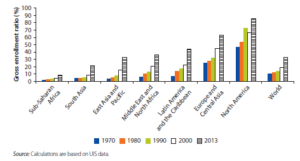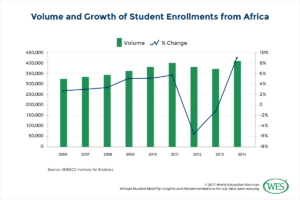Over the last few decades, enrolment in tertiary education grew faster in Sub-Saharan Africa than in any other region. While fewer than 200,000 students were enrolled for tertiary education in the region in 1970, the number soared to over 8.1 million in 2020.
Similarly, the number of universities in the region has grown steadily from about 100 to over 1,225 in the same period.
Unfortunately, the tertiary enrolment rate in Sub-Saharan Africa—standing at 9.4% according to UNESCO statistics—is still significantly below the global average of 38%. Even with a growth rate of 4.3% annually from 1970 to 2013 (faster than the global average of 2.8%), Sub-Saharan Africa has the lowest tertiary gross enrolment ratio globally.

Gross enrollment ratio, by region, 1970-2013
The expansion in Sub-Saharan Africa’s tertiary education is, unfortunately, an insufficient match for the rising demand driven by a rapidly growing college-age population.
Youth between ages 15 and 24 constitute 20% of Sub-Saharan Africa’s total population. Numbering over 200 million and expected to increase to 522 million by 2050 as the rest of the world’s youth population declines, this youthful population makes the region a growing target market for recruiting international students.
Africa Leads in International Student Mobility
It is, therefore, no surprise that Sub-Saharan Africa leads the world in international student mobility. According to a report by Campus France, about 5% of the 8.1 million tertiary students on the continent have crossed a border in their educational pursuit, as compared to the global average of 2.4%.
The report indicated that there are 404,000 students from Sub-Saharan Africa studying in universities abroad. With the total international student population projected to exceed 300 million by 2027, indicators suggest the region’s number of outbound students will continue to grow.

Africa’s student mobility
The Gap Between Secondary and Tertiary Education
Beyond the demographic surges, other factors drive students from Sub-Saharan Africa to pursue higher education abroad. One of these factors is the gap in enrolment between secondary and tertiary education. This difference in gross enrolment ratio (GER) means that many students completing secondary education won’t have access to higher education, even when academically eligible.
Despite major strides, tertiary education systems in Sub-Saharan Africa are ill-equipped to absorb the growing demand resulting from increased access to primary and secondary education. For instance, the region’s GER for the upper secondary level was 19% in 1999, five times that of tertiary education at the time—which was 4%.
At 9.4% in 2020, the tertiary GER on the continent is still woefully low compared to 34% for upper secondary education. To grasp the gravity of the situation, bear in mind that the global GER for upper secondary is twice that of tertiary education.
Other factors driving the demand for global universities in Africa include a shift from agriculture to manufacturing and services, unavailability of certain programs in universities in home countries, economic and political instability, the desire to discover other cultures, and the pursuit for higher-quality tertiary education.
The Question of Affordability
Even though Africa has the fastest-growing middle class worldwide, there’s the nagging question of affordability when it comes to pursuing higher education abroad. With a booming population of over 1.4 billion, Sub-Saharan Africa’s gross domestic product (GDP) per capita for 2019 was $1,596. Compare this to Belgium’s GDP per capita of $47540.90 in the same year.
Many of Africa’s promising potential international students are, therefore, locked out of accessing global universities due to affordability— especially considering international students often pay more for their education than their domestic counterparts.
For instance, international undergraduate students at public universities in the US pay an average of $25,000-$35,000 per year. For those opting for private colleges, the cost can go up to $50,000-$55,000 per year. In comparison, a typical four-year public college in America charges in-state students $10,230 per year, while private non-profit colleges charge $35,000 on average.
This glaring disparity was highlighted when WorldQuant University offered the first free online master’s degree in Financial Engineering. The expectation was that the majority of students would come from India and China, the traditional markets for international student recruitment for Europe and the US. To their amazement, 49% of the applicants were African, with 28% coming from Nigeria alone. India constituted only 8% of the applicants.
Meeting Africa’s Demand for Global University Education
As global universities seek ways to diversify international student recruitment, they can no longer afford to ignore Sub-Saharan Africa’s rising demand for affordable quality education abroad.
8B Education Investments was founded to help bridge this gap in funding for outbound African international students. We’re dedicated to lowering the barriers to access for African students, matching them with the financial, university, and employer networks they need to succeed.



